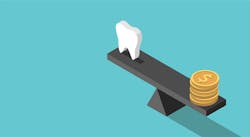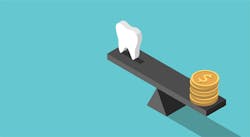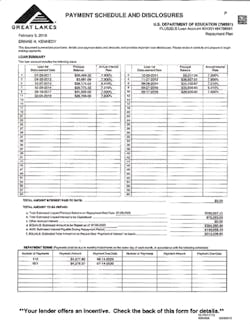The truth about dental student loans
Erinne Kennedy, DMD, MPH
Today’s strategies for the repayment of dental school loans are simply a Band-Aid for a larger public policy issue around student debt.
Consider this example: In 1983, my father graduated from The Ohio State University
College of Dental Medicine as a general dentist. He owed $40,000 dollars for his education. Six months after graduation, he started to make payments on his 10-year loan. Interest started to accrue when he began making payments. In those days, interest rates for education loans were around 8.5%. This was a time when mortgage rates for homes were around 13%.1
Now compare this to my experience. I took out my first loan to pay for my dental education in 2011. On the day my loan was activated—the day I began classes—I started to accrue interest on that loan. The interest rates on my loans range from 6% to 8%. That’s nearly twice the rate of a current 30-year fixed mortgage, which is about 4%.1
Illustration 108590842 © Dmitry Guzhanin | Dreamstime.com
The bottom line is this: For today’s dental students, not only is it how much they are paying in interest on their student loans, but when their student loans begin to accrue interest. The current arrangement is costing dental students and upcoming dental professionals dearly. The time for a policy change has come.
You might be thinking, “Can policy really make a difference?” or “Maybe dental education is simply expensive.” Yes, dental education is expensive. It is important to recognize the fact that tuition for dental school has risen sharply over the last few decades. However, to better understand the role of policy as it pertains to interest rates, look at my student loan statement that will come due six months after my graduation in December 2019 (figure 1). You will see that I owe about $289,000 in principal (my tuition) and about 75% of that amount in interest—about $224,000.
Figure 1: Student loan statement showing interest accrued while the author was still in dental school
Dental students are shocked when they look at their first statement and find they owe close to double their tuition—and for a good reason. Frequently, statistics on dental student debt that are reported by dental organizations do not include accrued interest.
For example, in 2018, the American Dental Education Association reported that average dental student debt was $285,184.2 This is precisely why students are baffled when they see their bill for half a million dollars. Compounding the problem is that policy makers are being told that dental school is “only” a quarter of a million dollars.
No, it’s not the tuition that is causing the craze. It’s the accrued interest. Creating policy to change when and how much interest students are charged is crucial to health professionals nationwide.
You might be asking, “Why is this happening?” The answer is this: it started with a policy change on July 1, 2010, so that the accrual of interest would start upon check disbursement instead of six months after graduation.3
In 2018 and 2019, the American Dental Association expressed support for a Dental Faculty Loan Repayment Program, which supports loan repayment opportunities for new graduates.4 In addition, the ADA partnered with Laurel Roads to help with loan consolidation and refinancing for dentists with student loans.5 I am pleased about these opportunities for loan repayment, but these are only a Band-Aid for the problem. A better solution is preventing the accrual of the interest in the first place.
In March 2019, legislators introduced the Resident Education Deferred Interest Act to allow medical and dental students to defer interest while in residency programs. This legislation, supported by the ADA, is an important step toward addressing challenges around student debt.
For me, I relate policy to our practice of dentistry. Think about the patients who have the highest caries risk in our offices today. We would not be helping them if we simply treated them by placing restoration after restoration. As clinicians, we need to uncover why our patients are at high caries risk in the first place. Then we can create solutions to address the causes. Likewise, policies on student debt should target the problems, such as when interest starts to accrue, in addition to creating repayment solutions.
In my opinion, we as health-care providers should lobby for two policies around interest rates: First, interest should not start accruing until the first payment is due. It should begin six months after graduation. Second, interest rates should reflect the loan default rate of the profession. For dentistry, this rate is miniscule.
Can you imagine the impact these policies would have on our lives and the profession? For me, I would have already saved $224,341.54 and feel more confident in delivering excellent health care. Instead, I feel like I have to find a way to get by.
The profession of dentistry needs to act with urgency. In 2017, we lost protection for many students struggling to pay back their loans.6 I encourage you to exercise your civic duty on this matter by writing Congress, lobbying, supporting, and being vocal in organized dentistry. Our voices matter, and they need to be heard.
References
1. Mortgage Rates History. FedPrimeRate.com website. http://www.fedprimerate.com/mortgage_rates.htm. Updated April 16, 2019.
2. Educational debt. American Dental Education Association website. https://www.adea.org/GoDental/Money_Matters/Educational_Debt.aspx.
3. Terms and conditions of student loans. Santa Monica College website. http://www.smc.edu/EnrollmentDevelopment/FinAid/Pages/Terms-and-Conditions-of-Student-Loans.aspx.
4. Student Loans and Postgraduate Educational Debt. American Dental Association website. https://www.ada.org/en/advocacy/advocacy-issues/student-debt. Updated February 26, 2019.
5. Student Loan Refinancing. American Dental Association website. https://www.ada.org/en/member-center/ada-for-new-dentists/manage-my-debt/refinancing.
6. Bendix A. Trump Reverses Obama-Era Protections on Student Debt. https://www.theatlantic.com/education/archive/2017/03/trump-reverses-obama-era-protections-on-student-debt/520059/. Published March 17, 2017.
ERINNE KENNEDY, DMD, MPH, graduated from Nova Southeastern College of Dental Medicine in 2015. She completed a one-year general practice residency at a VA Hospital in 2016 and her dental public health residency in 2018. Kennedy is currently the inaugural student in the master of medical science in dental education program at Harvard School of Dental Medicine and graduates in May 2019. She serves at a local community health center in Boston, Massachusetts. Contact her at [email protected].


